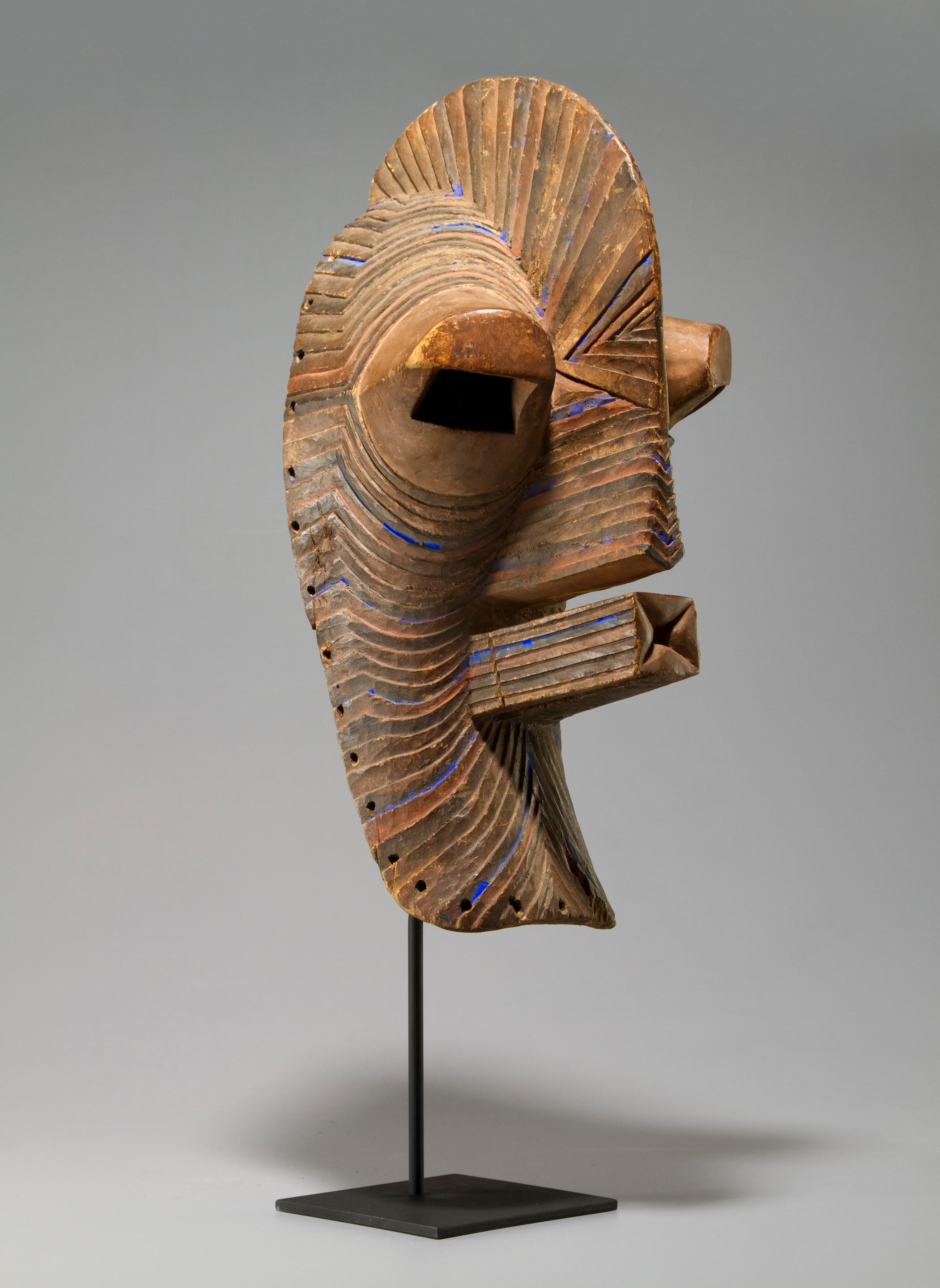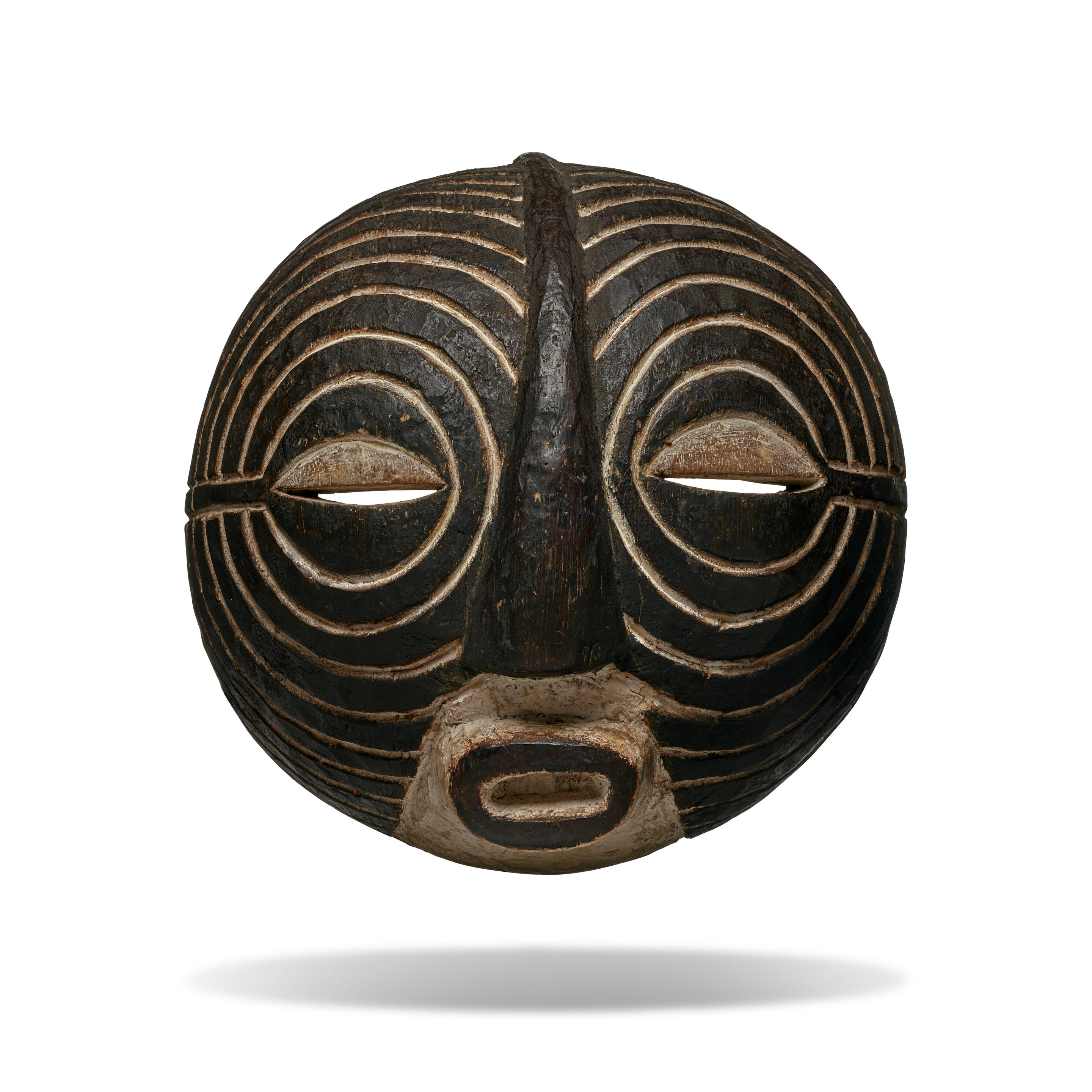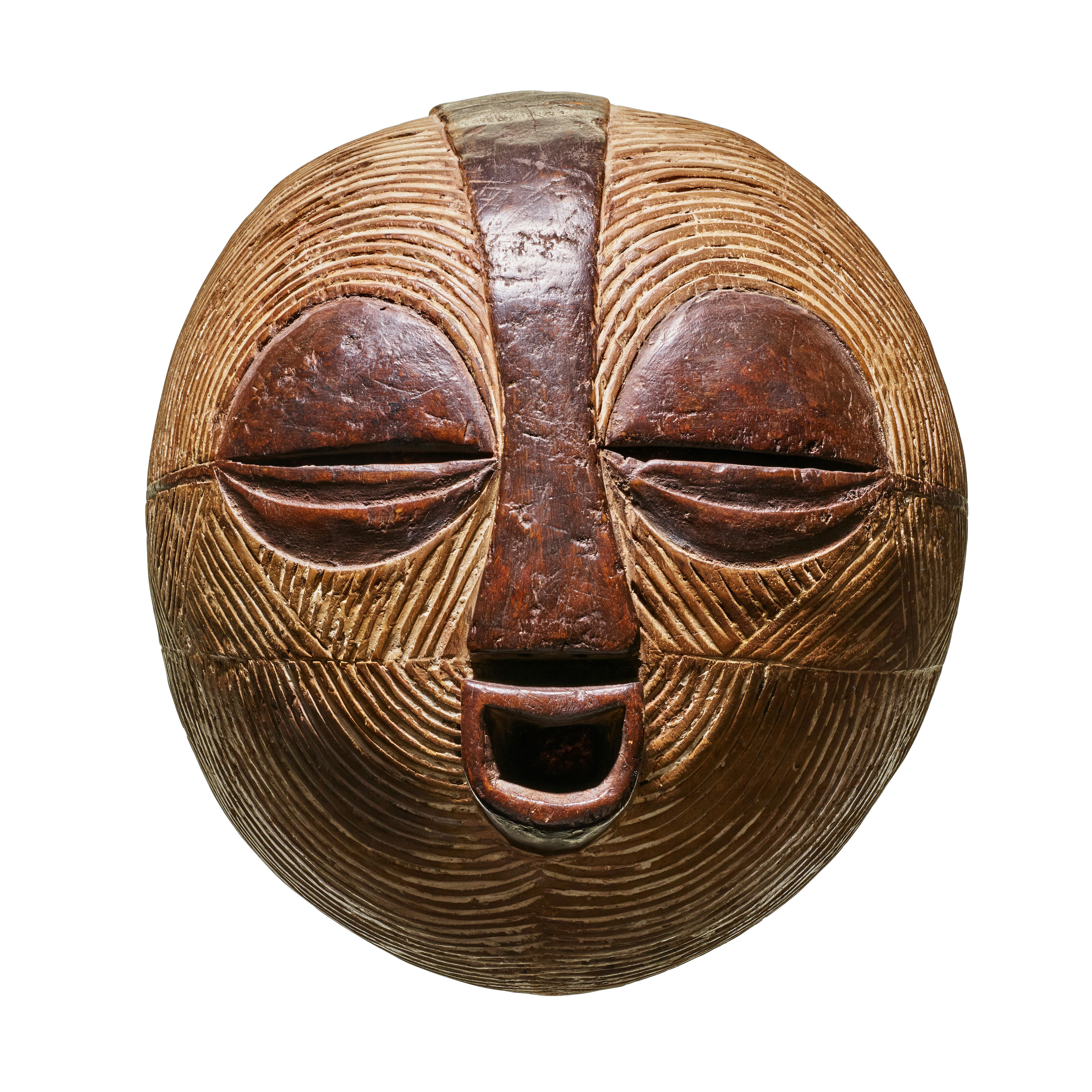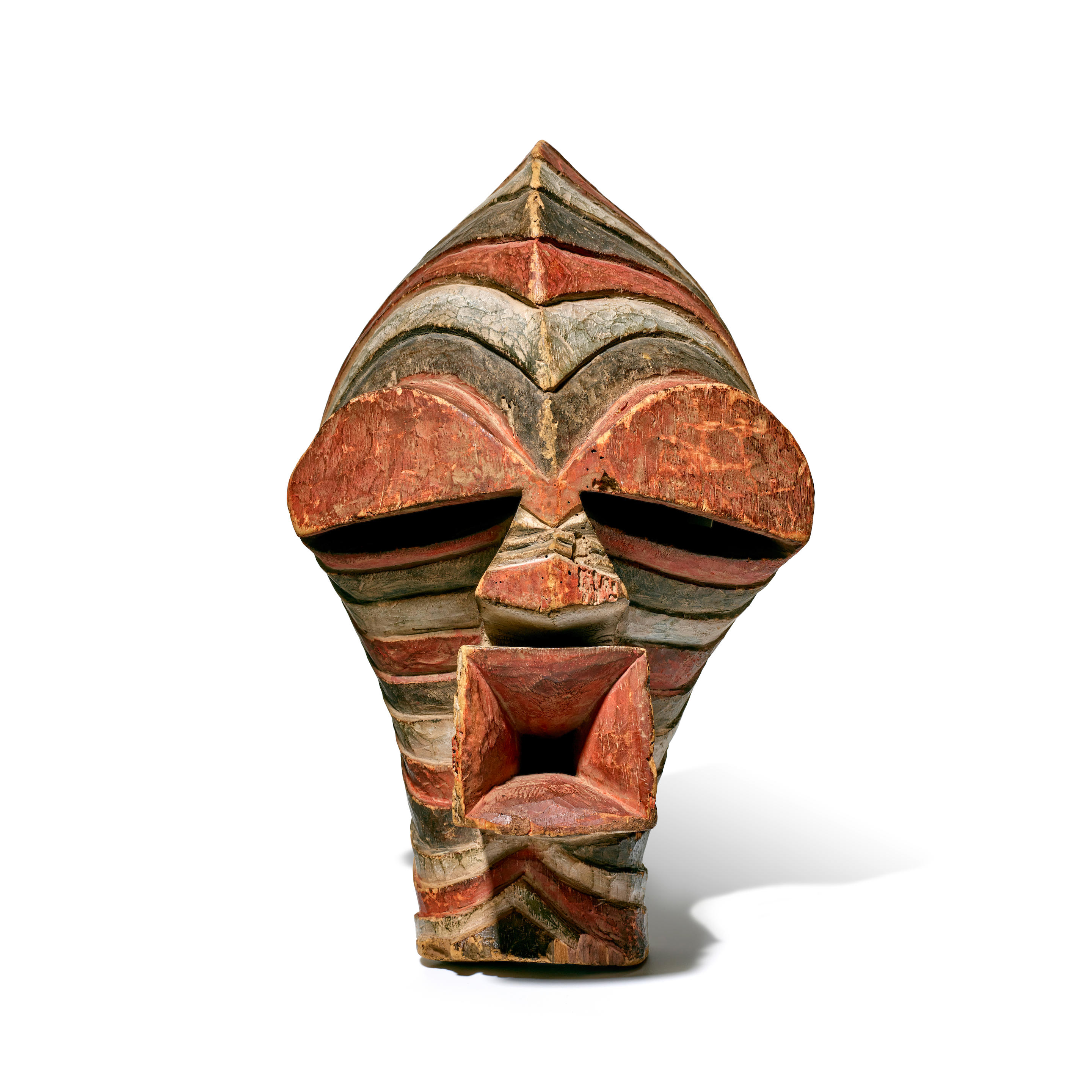kifwebe height 12in (30.5cm) Provenance Probably René Withofs, Brussels Marc Leo Felix, Brussels William McGuire Collection, Minnesota Michael Oliver Gallery, New York Leon Meizlik Collection, Westchester, New York, acquired in 2002 In an accompanying letter from Jean-Willy Mestach dated December 9, 2002, Mr. Mestach comments that the present work is "a beautiful mask by a known master." According to Zoë Strothers, "Some Luba share the bwadi bwa kifwebe society with the Songye, but their conception is more benefiting than threatening. Luba attribute its origins to three spirits, which emerged from a ditch near a lake. The female spirit was attracted by humans and went to live among them. The two male spirits stayed in the bush, but visited the village where they dazzled the inhabitants with their dancing to the point where the men begged to be initiated. The grooves marking the surface of kifwebe refer to the ditch from which the founding spirits emerged (Mutimanwa Wenga-Mulayi, 'Etude socio-morphologique des masques blancs luba ou "bifwebe"', unpublished M.A. thesis, Université Nationale du Zaïre, Lubumbashi, 1974). The masks therefore are marked with signs of the other world. (Bassani, Ezio, Michael Bockenmühl, and Patrick McNaughton (eds.), The Power of Form - African Art from the Horstmann Collection, Skira, 2002, p. 164) Dunja Hersak further notes, "The bwadi bwa kifwebe society is present both among the Songye and the Luba peoples. For the Songye the society functions as a mechanism of control in the service of the ruling elite. For the Luba, it is associated with benevolent practices like purifying the community of the evil spirits of sorcerers and the dead. Kifwebe masks represent an abstracted human face. The patterns of geometric grooves give them an added dimension, leading to the creation of a being that seems to stand beyond the norms order of the universe. Still, these grooves are not abstract. They find their origin among various animals with striped quills, fur or skin. These are the striped porcupine, the zebra, the forest antelope, and a snake which bears the native name ngulungu. To these should be added still other characteristics that are ascribed to them in mythology." (Herremen, Frank and Constantijn Petridis (eds.), Face of the Spirits: Masks from the Zaïre Basin, Gent, 1993, p. 61) The artist of this rare example has masterfully combined both the profound power found in Songye art with the refined elegance typically discovered in Luba art. The composition is a complex juxtaposition of curves and angles, tension and tranquility, light and dark. From the front, the mask takes on a rounded hourglass shape, dissected down the middle with a nose sharply angled in triangular form at the base, above a similarly sharply angled, hourglass shaped mouth. The back rim slopes gently forward and extends just past the mouth in profile. The incised lines on the top of the head run straight downwards, then break at the line of the eye, curving in parallel with the rounded eye, contrasting the vertical straight lines on the eyelids. Light brown patina with wear and age to the wood suggest this is a particularly early example, used for a long period of time in situ; two collection labels, "112" written in white on top back rim and "4157" written in pencil on back behind the nose. Cf. University of Iowa Stanley Museum of Art, The Stanley Collection of African Art, X1986.551, for a similar example, possibly by the same hand.
kifwebe height 12in (30.5cm) Provenance Probably René Withofs, Brussels Marc Leo Felix, Brussels William McGuire Collection, Minnesota Michael Oliver Gallery, New York Leon Meizlik Collection, Westchester, New York, acquired in 2002 In an accompanying letter from Jean-Willy Mestach dated December 9, 2002, Mr. Mestach comments that the present work is "a beautiful mask by a known master." According to Zoë Strothers, "Some Luba share the bwadi bwa kifwebe society with the Songye, but their conception is more benefiting than threatening. Luba attribute its origins to three spirits, which emerged from a ditch near a lake. The female spirit was attracted by humans and went to live among them. The two male spirits stayed in the bush, but visited the village where they dazzled the inhabitants with their dancing to the point where the men begged to be initiated. The grooves marking the surface of kifwebe refer to the ditch from which the founding spirits emerged (Mutimanwa Wenga-Mulayi, 'Etude socio-morphologique des masques blancs luba ou "bifwebe"', unpublished M.A. thesis, Université Nationale du Zaïre, Lubumbashi, 1974). The masks therefore are marked with signs of the other world. (Bassani, Ezio, Michael Bockenmühl, and Patrick McNaughton (eds.), The Power of Form - African Art from the Horstmann Collection, Skira, 2002, p. 164) Dunja Hersak further notes, "The bwadi bwa kifwebe society is present both among the Songye and the Luba peoples. For the Songye the society functions as a mechanism of control in the service of the ruling elite. For the Luba, it is associated with benevolent practices like purifying the community of the evil spirits of sorcerers and the dead. Kifwebe masks represent an abstracted human face. The patterns of geometric grooves give them an added dimension, leading to the creation of a being that seems to stand beyond the norms order of the universe. Still, these grooves are not abstract. They find their origin among various animals with striped quills, fur or skin. These are the striped porcupine, the zebra, the forest antelope, and a snake which bears the native name ngulungu. To these should be added still other characteristics that are ascribed to them in mythology." (Herremen, Frank and Constantijn Petridis (eds.), Face of the Spirits: Masks from the Zaïre Basin, Gent, 1993, p. 61) The artist of this rare example has masterfully combined both the profound power found in Songye art with the refined elegance typically discovered in Luba art. The composition is a complex juxtaposition of curves and angles, tension and tranquility, light and dark. From the front, the mask takes on a rounded hourglass shape, dissected down the middle with a nose sharply angled in triangular form at the base, above a similarly sharply angled, hourglass shaped mouth. The back rim slopes gently forward and extends just past the mouth in profile. The incised lines on the top of the head run straight downwards, then break at the line of the eye, curving in parallel with the rounded eye, contrasting the vertical straight lines on the eyelids. Light brown patina with wear and age to the wood suggest this is a particularly early example, used for a long period of time in situ; two collection labels, "112" written in white on top back rim and "4157" written in pencil on back behind the nose. Cf. University of Iowa Stanley Museum of Art, The Stanley Collection of African Art, X1986.551, for a similar example, possibly by the same hand.












Testen Sie LotSearch und seine Premium-Features 7 Tage - ohne Kosten!
Lassen Sie sich automatisch über neue Objekte in kommenden Auktionen benachrichtigen.
Suchauftrag anlegen